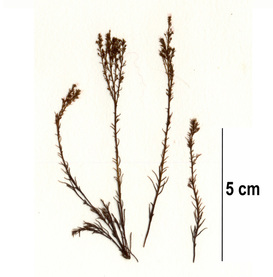Oregon pine • Neorhodomela oregona
{Neorhodomela = new red and black}
|
Specimen collection number SCL 15361 in the UBC Herbarium Algae Database. Search the specimen collection number in the database for further information, or search the species for more information. Images courtesy of Sandra Lindstrom.
|
Identification
Oregon pine is a tough perennial red seaweed. It is black or dark brown in colour — though it may be bleached lighter brown — and has a coarse, wiry texture. It has loose, indeterminate branching. Branches are circular in cross-section and tapering (terete). Small, slender branchlets radiate from all sides of this seaweeds main axis. Oregon pine has a disc-shaped holdfast, grows to 17 cm tall, and forms large, dense mats.
Habitat & Range
Oregon pine grows on rock in the mid to low intertidal, and is often found in tidepools. It is a common and abundant species along protected to semi-protected shorelines. Its range extends from the Bering Sea and Aleutian Islands in Alaska to central California. It is also found along coastlines in Japan and Russia.
Similar Species
The other species of the same genus commonly found in coastal BC waters is black pine (Neorhodomela larix). While it is similar to Oregon pine, the two are not difficult to tell apart. Black pine is stiffer and coarser than Oregon pine, and branches less frequently. The branchlets of black pine are bunched together in a bottle-brush fashion, creating a knobbly appearance. Other similar species include graceful black pine (N. aculeata), sea brush (Odonthalia floccosa), and bleached brunette (Cryptosiphonia woodii).
Oregon pine is a tough perennial red seaweed. It is black or dark brown in colour — though it may be bleached lighter brown — and has a coarse, wiry texture. It has loose, indeterminate branching. Branches are circular in cross-section and tapering (terete). Small, slender branchlets radiate from all sides of this seaweeds main axis. Oregon pine has a disc-shaped holdfast, grows to 17 cm tall, and forms large, dense mats.
Habitat & Range
Oregon pine grows on rock in the mid to low intertidal, and is often found in tidepools. It is a common and abundant species along protected to semi-protected shorelines. Its range extends from the Bering Sea and Aleutian Islands in Alaska to central California. It is also found along coastlines in Japan and Russia.
Similar Species
The other species of the same genus commonly found in coastal BC waters is black pine (Neorhodomela larix). While it is similar to Oregon pine, the two are not difficult to tell apart. Black pine is stiffer and coarser than Oregon pine, and branches less frequently. The branchlets of black pine are bunched together in a bottle-brush fashion, creating a knobbly appearance. Other similar species include graceful black pine (N. aculeata), sea brush (Odonthalia floccosa), and bleached brunette (Cryptosiphonia woodii).
References
Lindberg, M. and Lindstrom, S. (2010). Neorhodomela oregona Oregon Pine. Seaweeds of Alaska. Accessed 16/09/2015.
Druehl, L. 2000. Pacific Seaweeds: A guide to common seaweeds of the west coast. Harbour Publishing: Madeira Park, BC, Canada. Pp. 124-125.
O'Clair, R. and Lindsrom, S. Neorhodomela oregona (Doty) Masuda. In Klinkenberg, Brian. (Ed.). E-Flora BC: Electronic Atlas of the Plants of British Columbia. Lab for Advanced Spatial Analysis, Department of Geography, University of British Columbia, Vancouver. Accessed 16/09/2015.
Authors and editors of page
Kelly Fretwell and Brian Starzomski (2015).
Lindberg, M. and Lindstrom, S. (2010). Neorhodomela oregona Oregon Pine. Seaweeds of Alaska. Accessed 16/09/2015.
Druehl, L. 2000. Pacific Seaweeds: A guide to common seaweeds of the west coast. Harbour Publishing: Madeira Park, BC, Canada. Pp. 124-125.
O'Clair, R. and Lindsrom, S. Neorhodomela oregona (Doty) Masuda. In Klinkenberg, Brian. (Ed.). E-Flora BC: Electronic Atlas of the Plants of British Columbia. Lab for Advanced Spatial Analysis, Department of Geography, University of British Columbia, Vancouver. Accessed 16/09/2015.
Authors and editors of page
Kelly Fretwell and Brian Starzomski (2015).






